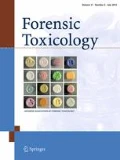Abstract
Purpose
Impurity profiling is an important intelligence-gathering tool that can be used to link batches of drugs, and it provides valuable insights into manufacturing and supply trends in new psychoactive substances. In a routine analysis, we detected trace amounts of pyrovalerone in illicit drug products. In this study, we investigated the cause of pyrovalerone’s presence in the illicit drug products containing 4′-methyl-α-pyrrolidinohexanophenone (MPHP) or 4-methyl-α-ethylaminopentiophenone (4-methyl-α-EAPP).
Methods
We analyzed the compounds in illicit drug products and raw material using liquid chromatography–photodiode array detection, gas chromatography–mass spectrometry and liquid chromatography–mass spectrometry.
Results
We detected trace amounts of pyrovalerone in four illicit drug products containing MPHP or 4-methyl-α-EAPP. In every case, the amount of pyrovalerone in the illicit drug products was much lower than that of MPHP or 4-methyl-α-EAPP. We assumed that pyrovalerone was produced unintentionally. Structurally, pyrovalerone differs from MPHP with respect to the length of the alkyl side chain, and for 4-methyl-α-EAPP, the amine at the α-position is different (it bears an ethylamine instead of pyrrolidine). Pyrovalerone is thought to be produced in two different ways, as a synthetic by-product of both MPHP and 4-methyl-α-EAPP.
Conclusions
We assumed that pyrovalerone was derived from an impurity in a raw material or arose from contamination during the amination process. Impurity analysis, such as that described in this study, will aid in impurity profiling of cathinones.






References
Leffler AM, Smith PB, Armas A, Dorman FL (2014) The analytical investigation of synthetic street drugs containing cathinone analogs. Forensic Sci Int 234:50–56
Uchiyama N, Matsuda S, Kawamura M, Kikura-Hanajiri R, Goda Y (2013) Two new-type cannabimimetic quinolinyl carboxylates, QUPIC and QUCHIC, two new cannabimimetic carboxamide derivatives, ADB-FUBINACA and ADBICA, and five synthetic cannabinoids detected with a thiophene derivative α-PVT and an opioid receptor agonist AH-7921 identified in illegal products. Forensic Toxicol 31:223–240
Uemura N, Fukaya H, Kanai C, Yoshida M, Nakajima J, Takahashi M, Suzuki J, Moriyasu T, Nakae D (2014) Identification of a synthetic cannabinoid A-836339 as a novel compound found in a product. Forensic Toxicol 32:45–50
Zaitsu K, Katagi M, Tsuchihashi H, Ishii A (2014) Recently abused synthetic cathinones, α-pyrrolidinophenone derivatives: a review of their pharmacology, acute toxicity, and metabolism. Forensic Toxicol 32:1–8
Zuba D, Geppert B, Sekuła K, Żaba C (2013) [1-(Tetrahydropyran-4-ylmethyl)-1H-indol-3-yl]-(2, 2, 3, 3-tetramethylcyclopropyl) methanone: a new synthetic cannabinoid identified on the drug market. Forensic Toxicol 31:281–291
Kohyama E, Chikumoto T, Tada H, Kitaichi K, Ito K (2017) Analytical differentiation of quinolinyl- and isoquinolinyl-substituted 1-(5-fluoropentyl)-1H-indole-3-carboxylates: 5F-PB-22 and its ten isomers. Forensic Toxicol 35:56–65
Kikura-Hanajiri R, Uchiyama N, Kawamura M, Goda Y (2013) Changes in the prevalence of new psychoactive substances before and after the introduction of the generic scheduling of synthetic cannabinoids in Japan. Drug Test Anal 6:832–839
Dayrit FM, Dumlao MC (2004) Impurity profiling of methamphetamine hydrochloride drugs seized in the Philippines. Forensic Sci Int 144:29–36
King LA, Clarke K, Orpet AJ (1994) Amphetamine profiling in the UK. Forensic Sci Int 69:65–75
Kavanagh PV, Power JD (2014) New psychoactive substances legislation in Ireland—perspectives from academia. Drug Test Anal 6:884–891
Pütz M, Schneiders S, Auwärter V, Münster-Müller S, Scheid N (2015) The EU-project ‘SPICE-profiling’ (2015–2017)—objectives and results of a first study on spice products containing 5F-PB-22. Toxichem Krimtech 82:273–283
Heather E, Bortz A, Shimmon R, McDonagh AM (2017) Organic impurity profiling of methylone and intermediate compounds synthesized from catechol. Drug Test Anal 9:436–445
Archer RP (2009) Fluoromethcathinone, a new substance of abuse. Forensic Sci Int 185:10–20
Meltzer PC, Butler D, Deschamps JR, Madras BK (2006) 1-(4-Methylphenyl)-2-pyrrolidin-1-yl-pentan-1-one (pyrovalerone) analogues: a promising class of monoamine uptake inhibitors. J Med Chem 49:1420–1432
Asada A, Doi T, Takeda A, Tagami T, Kawaguchi M, Satsuki Y, Sawabe Y (2015) Identification of analogs of LY2183240 and the LY2183240 2′-isomer in herbal products. Forensic Toxicol 33:311–320
Doi T, Asada A, Takeda A, Tagami T, Katagi M, Matsuda S, Kamata H, Kawaguchi M, Satsuki Y, Sawabe Y, Obana H (2016) Identification and characterization of α-PVT, α-PBT, and their bromothienyl analogs found in illicit drug products. Forensic Toxicol 34:76–93
McDermott SD, Power JD, Kavanagh P, O’Brien J (2011) The analysis of substituted cathinones. Part 2: an investigation into the phenylacetone based isomers of 4-methylmethcathinone and N-ethylcathinone. Forensic Sci Int 212:13–21
Westphal F, Junge T, Girreser U, Greibl W, Doering C (2012) Mass, NMR and IR spectroscopic characterization of pentedrone and pentylone and identification of their isocathinone by-products. Forensic Sci Int 217:157–167
Uchiyama N, Matusda S, Kawamura M, Shimokawa Y, Kikura-Hanajiri R, Aritake K, Urade Y, Goda Y (2014) Characterization of four new designer drugs, 5-chloro-NNEI, NNEI indazole analog, α-PHPP and α-POP, with 11 newly distributed designer drugs in illegal products. Forensic Sci Int 243:1–13
Uchiyama N, Shimokawa Y, Kawamura M, Kikura-Hanajiri R, Hakamatsuka T (2014) Chemical analysis of a benzofuran derivative, 2-(2-ethylaminopropyl) benzofuran (2-EAPB), eight synthetic cannabinoids, five cathinone derivatives, and five other designer drugs newly detected in illegal products. Forensic Toxicol 32:266–281
Acknowledgements
This study was supported in part by JSPS KAKENHI Grant no. 15K08834.
Author information
Authors and Affiliations
Corresponding author
Ethics declarations
Conflict of interest
There are no financial or other relations that could lead to a conflict of interest.
Ethical approval
This article does not contain any studies with human participants or animals performed by any of the authors.
Rights and permissions
About this article
Cite this article
Tagami, T., Doi, T., Takeda, A. et al. Detection of pyrovalerone as a possible synthetic by-product of 4′-methyl-α-pyrrolidinohexanophenone and 4-methyl-α-ethylaminopentiophenone in illicit drug products. Forensic Toxicol 36, 506–513 (2018). https://doi.org/10.1007/s11419-018-0407-z
Received:
Accepted:
Published:
Issue Date:
DOI: https://doi.org/10.1007/s11419-018-0407-z

